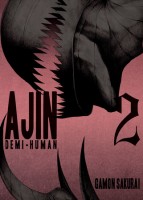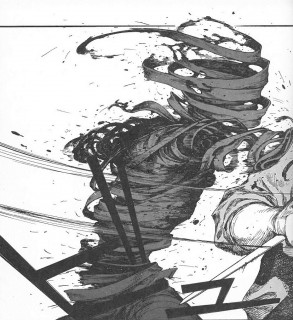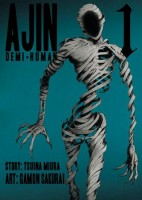 Creator: Gamon Sakurai
Creator: Gamon Sakurai
U.S. publisher: Vertical
ISBN: 9781939130853
Released: December 2014
Original release: 2013
I tend to enjoy darker-toned stories about immortals, so I wasn’t particularly surprised that I enjoyed the first volume of Ajin: Demi-Human. The manga series was conceived of by writer Tsuina Miura and artist Gamon Sakurai, but by the second volume it appears as though Sakurai has taken over the story of Ajin as well. (Although, it should be noted that Miura and Sakurai’s pilot chapter for Ajin, “The Shinya Nakamura Incident,” is also included in the series’ second volume.) Ajin: Demi-Human, Volume 2 was originally published in Japan in 2013 while the English-language edition of the manga was released by Vertical at the end of 2014. The first volume of the series established an intriguing premise—immortal beings, considered to be less than human, who are persecuted and subjected to cruel experiments—as well as an exceptionally dark atmosphere, and so I was particularly interested in seeing where Sakurai would take the story next.
Kei is on the run. Recently discovered to be an immortal demi-human—only the third to have been officially confirmed to exist in Japan—he is trying to avoid capture by the Demi-Human Control Commission and hoping to find allies in other immortals. When he is contacted by two rogue demi-humans, Sato (also known as “Hat”) and Tanaka, it seems as though Kei’s hopes have been answered, except for the small matter of the two men having taken his sister hostage. But with a little bit of effort and some unexpected theatrics, Sato is able to readily explain away the kidnapping and even manages to earn Kei’s trust in the process. Though Kei is unaware of it at the time, that misplaced trust will have severe repercussions for him. Sato and Tanaka are very interested in the young man. Not only is he a demi-human, just like the two of them Kei is a variant immortal capable of manifesting and controlling a black ghost. However, it is a power that he has yet to understand or to completely control.
 Despite being a large focus of the first two volumes of Ajin and around whom much of the manga’s plot revolves, currently Kei is actually one of the least compelling characters in the series. The people and events surrounding Kei tend to be much more engaging. Sato in particular is a tremendous presence. It is easy to see why he instills such fear among those in the Demi-Human Control Commission—he cannot be controlled. Sato is a coldly calculating and ruthless strategist with extraordinary combat skills and the ability to manipulate both the people around him and the situations in which he finds himself. He is terrifyingly effective in the execution of his plans. At this point only some of those plans have been completely revealed, but it is obvious that Sato is willing to sacrifice anyone in order to accomplish them. In comparison, Kei seems to be incredibly weak-willed and naive, lacking a strong sense of self. Granted, almost anyone would when compared to Sato, but it’s also somewhat understandable since Kei’s entire worldview has been shattered. With his new-found immortality, he is still trying to understand who he is.
Despite being a large focus of the first two volumes of Ajin and around whom much of the manga’s plot revolves, currently Kei is actually one of the least compelling characters in the series. The people and events surrounding Kei tend to be much more engaging. Sato in particular is a tremendous presence. It is easy to see why he instills such fear among those in the Demi-Human Control Commission—he cannot be controlled. Sato is a coldly calculating and ruthless strategist with extraordinary combat skills and the ability to manipulate both the people around him and the situations in which he finds himself. He is terrifyingly effective in the execution of his plans. At this point only some of those plans have been completely revealed, but it is obvious that Sato is willing to sacrifice anyone in order to accomplish them. In comparison, Kei seems to be incredibly weak-willed and naive, lacking a strong sense of self. Granted, almost anyone would when compared to Sato, but it’s also somewhat understandable since Kei’s entire worldview has been shattered. With his new-found immortality, he is still trying to understand who he is.
Ajin is a very dark and violent manga. The experiments carried out on the demi-humans are brutal and cruel. Generally, the most graphic moments are implied rather than seen, but that makes the torture no less disturbing. Demi-humans, especially those controlling black ghosts, are more than capable of fighting back, though. For example, Sato’s repeated attacks on research facilities associated with the Demi-Human Control Commission and his complete disregard for life are astonishing. Sakurai’s artwork is particularly effective during action sequences, of which there are plenty in the second volume of Ajin. The second volume also addresses some of the social issues surrounding demi-humans, in particular the fact that not everyone feels that demi-humans should be discriminated against just because they happen to be immortal. So far, Sakurai has been able to strike a good balance between the series’ intense action and horror and its exploration of deeper moral and ethical concerns. I’m certainly looking forward to seeing how the series continues to develop.

